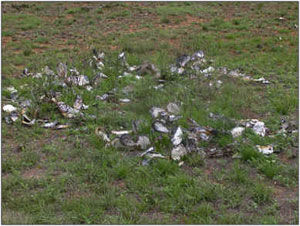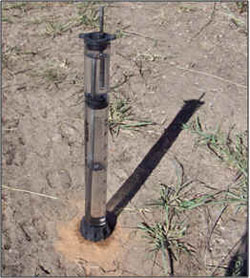Summer prescribed fires are being evaluated as a means of reducing woody plant and cactus cover and restoring herbaceous  vegetation in the Southern Great Plains of the U.S.A., but little is known regarding the impact of these fires combined with livestock grazing on rangeland ecosystems. We evaluated the impact and recovery of native rangeland vegetation and soils subjected to summer patch burns in continuously and rotationally grazed pastures in 2002, 2003 and 2004. Each year, 12% of each treatment replicate was burned as a single patch in a different, non-adjacent area under continuous grazing, and as a single paddock of a rotationally grazed 8-pasture-1-herd system. Replicates in each grazing treatment varied in size from 1295 to 2131 ha. To determine impact and recovery, vegetation and soil parameters on burned patches were measured annually until the summer of 2006 and compared to those in immediately adjacent unburned areas in both grazing treatments.
vegetation in the Southern Great Plains of the U.S.A., but little is known regarding the impact of these fires combined with livestock grazing on rangeland ecosystems. We evaluated the impact and recovery of native rangeland vegetation and soils subjected to summer patch burns in continuously and rotationally grazed pastures in 2002, 2003 and 2004. Each year, 12% of each treatment replicate was burned as a single patch in a different, non-adjacent area under continuous grazing, and as a single paddock of a rotationally grazed 8-pasture-1-herd system. Replicates in each grazing treatment varied in size from 1295 to 2131 ha. To determine impact and recovery, vegetation and soil parameters on burned patches were measured annually until the summer of 2006 and compared to those in immediately adjacent unburned areas in both grazing treatments.
Table 2. Soil temperature (oC) at 10 mm depth in no-burn control areas and following summer burning with continuous or rotational grazing under mesquite canopies or in open grassland between trees
| Treatment | Grass | Tree | ||||
| Continuous | Rotation | P | Continuous | Rotation | P | |
| No burn | 35.4 | 28.5 | 0.04 | 25.2 | 24.7 | 0.87 |
| Burn 2003 | 33.8 | 30.8 | 0.27 | 27.2 | 27.8 | 0.81 |
| Burn 2004 | 34.2 | 30.8 | 0.22 | 29.3 | 30.3 | 0.69 |
| Cont. vs. Rot. | 34.4 | 30.0 | 0.023 | 27.2 | 27.6 | 0.79 |
| Cont. vs. Rot. | 30.8 | 28.8 | 0.097 | |||
| Grass vs. Tree | 32.2 | 28.8 | 0.003 | |||
Sampling was conducted on 2 soils – one with greater mesquite cover and more C3 grasses (Tilvern series), and the other with more C4 grasses (Wichita series). Average or above-average precipitation was recorded during the experimental period. With both grazing treatments, herbaceous cover and biomass took 2 years to recover to control levels on Tilvern soils, and 3 years on Wichita soils. The rotational grazing treatment resulted in less bare ground on both unburned and burned areas than the continuously grazed treatment (p < 0.05). As a consequence, soil temperatures were lower (p < 0.01) and soil C and C: N ratios were higher with rotational grazing (p < 0.05). The lower levels of bare ground and soil temperatures with rotational grazing were most evident on unburned areas presumably because of the canopy reducing effects of fire on the burn treatments.
Table 3. Soil nitrogen, organic carbon and C to N ratio in the top 10 cm of soil following
summer burning with continuous or rotational grazing under mesquite tree canopies
or in open grassland between trees
| Soil parameter (Units) |
No burn control | Burn Treatment | Vegetation | Graze treatment | |||
| 2003 | 2004 | Grass | Tree | Continuous | Rotation | ||
| Total N (ppm) | 2159 | 2180 | 2069 | 1979 | 2294** | 2059 | 2213 |
| Organic carbon (%) | 3.6 | 3.6 | 3.5 | 3.5 | 4.1** | 3.3 | 3.8* |
| C : N | 9.4 | 9.3 | 9.4 | 9.5 | 9.2+ | 9.1 | 9.6** |
** p < 0.01; * p < 0.05; + p < 0.10 within each treatment category
 Soil physical parameters and infiltration rates were not affected by either the burn or grazing treatments (p > 0.05). In contrast, relative to open grassland, the presence of trees had a strong beneficial effect by reducing soil temperature, and improving soil physical parameters and infiltration rate (p < 0.05). Before summer burning can be advocated, research needs to determine what post-fire grazing management will be necessary to ensure burned areas have recovered plant and litter cover in below average precipitation periods.
Soil physical parameters and infiltration rates were not affected by either the burn or grazing treatments (p > 0.05). In contrast, relative to open grassland, the presence of trees had a strong beneficial effect by reducing soil temperature, and improving soil physical parameters and infiltration rate (p < 0.05). Before summer burning can be advocated, research needs to determine what post-fire grazing management will be necessary to ensure burned areas have recovered plant and litter cover in below average precipitation periods.